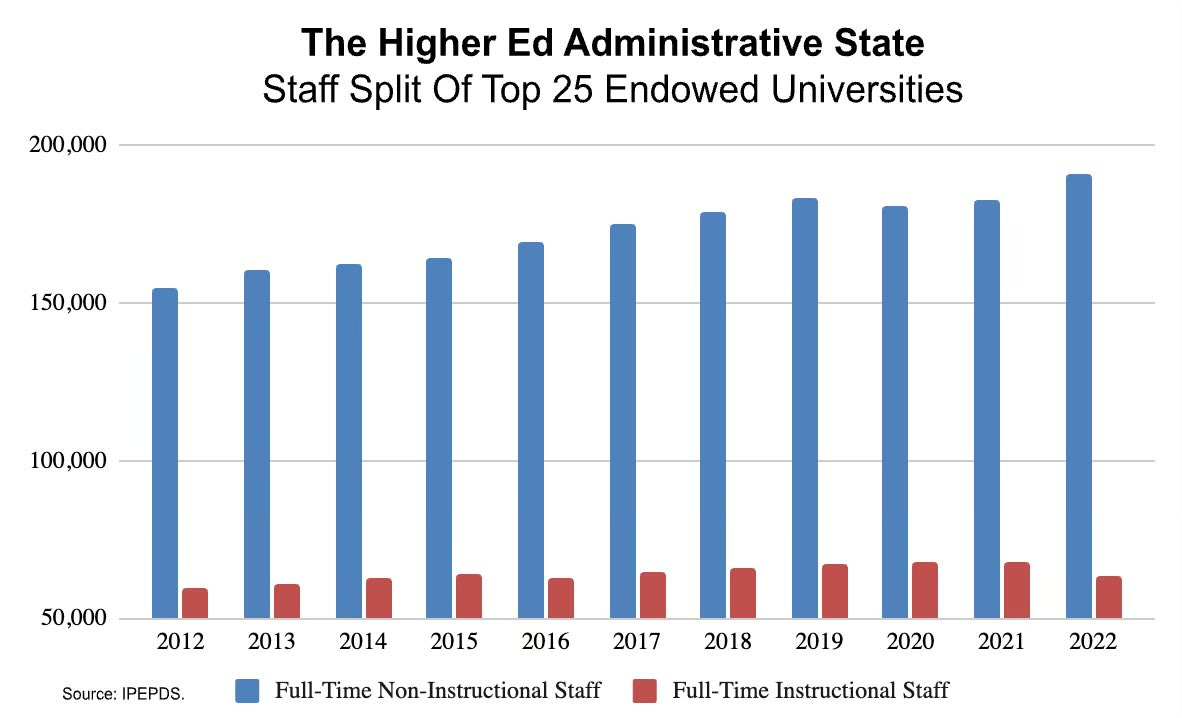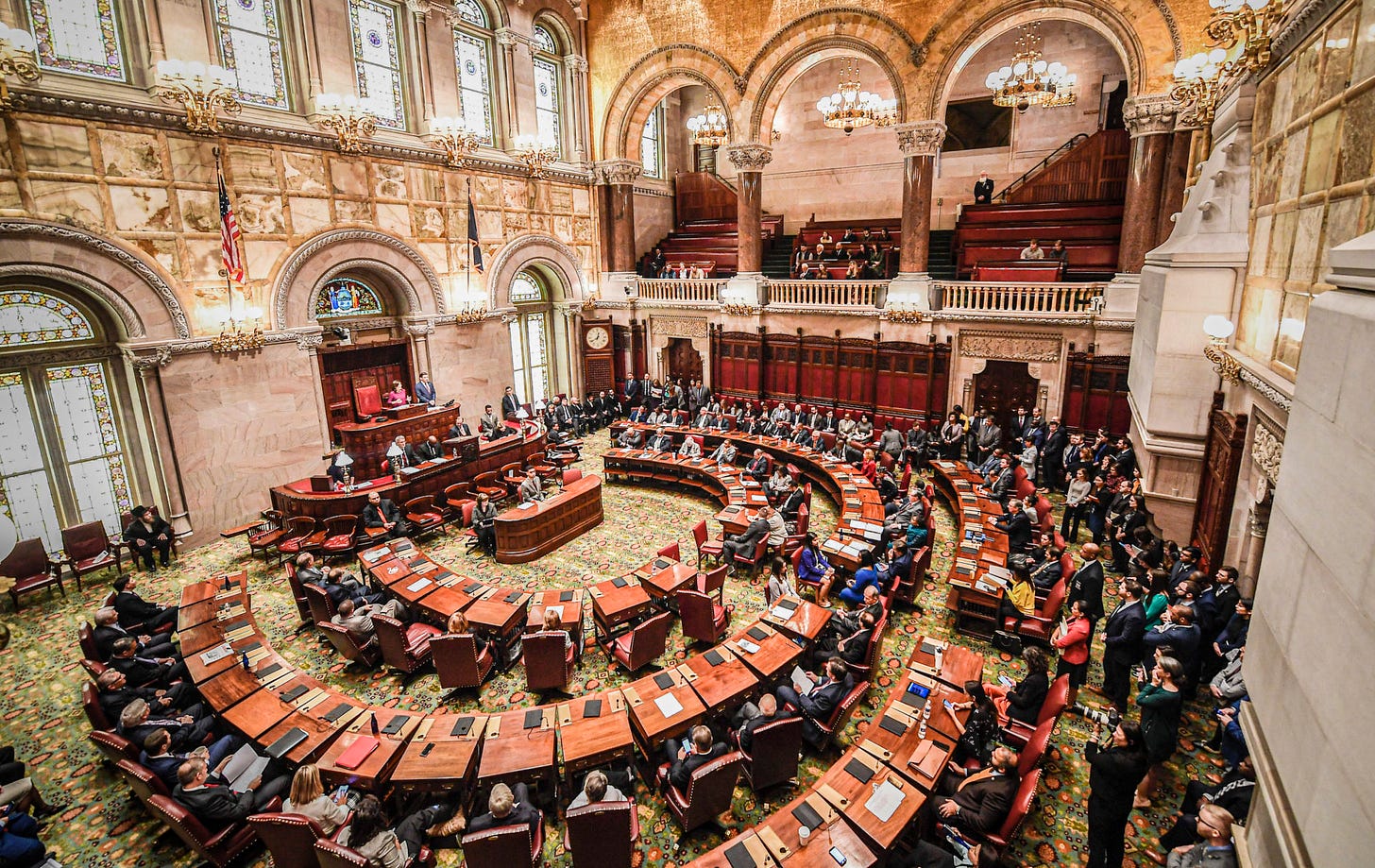Universities need to radically cut back on bureaucracy
in order to lower the cost of tuition and increase the quality of education
This article is part of a multi-part series on making university tuition more affordable without undermining the quality of education. As a former college professor, I have some unique insights into the problem and how to solve it.
In previous articles, I made the case that:
To lower the cost of tuition, amenities should be a separate optional line item.
In this article, I will argue that universities need to radically cut the amount of non-academic jobs in the university bureaucracy.
The following is an excerpt from my second book Promoting Progress: A Radical New Agenda to Create Abundance for All. You can order e-books at a discounted price at my website, or you can purchase for full price on Amazon.
Other books in my “From Poverty to Progress” book series:
Cutting Bureaucracy
Another major factor in our rapidly increasing tuition costs is bureaucratization. Over the last 50 years, the number of non-academic administrators per student has grown rapidly.
Between 1993 and 2007, the number of full-time administrators per 100 students increased by 39%, so they now make up double the number of employees dedicated to education. After adjusting for inflation, the cost of these administrators increased by 61%. In most universities, the majority of employees are not directly engaged in education or research. The lion’s share of this additional cost is paid for by state and federal governments (Greene).
Unfortunately, this growth in bureaucracy has accelerated over the last decade. The increase in hiring for Diversity, Equity, and Inclusion is particularly explosive. Ivy League universities now average a 1:1 ratio of administrators to students. In 2002-03 Yale University employed 3,500 administrators and managers, while it had 5,300 students. By 2021 Yale had more than 5,000 administrators and managers to 4,700 students (Chronicle of Higher Education).
There is absolutely no evidence that this ever-growing bureaucracy improves the quality of the education. In many cases, these administrators increase the quality of the amenities in the college experience, but, as discussed earlier, this is a double-edged sword. The better the amenities, the greater the distraction students have from academic work.
Moreover, these bureaucrats actually do something. They have built a huge administrative apparatus that has undermined the academic freedom of professors and the free speech of students. Far from creating an open learning experience, they are turning campuses into hives of groupthink mentality.
These bureaucrats have also empowered a relatively small proportion of left-wing students and professors to intimidate the entire campus. Because these administrators are well to the left of center in their politics, they often abuse their power by enforcing the rules differently, based on the politics of the perpetrators. Centrists and conservatives are punished far more severely for the same act compared to left-wing activists.
This has created an atmosphere on many campuses where Critical theory is the dominant ideology. Critical theory activists increasingly politicize all campus activities, and campus administrators allow them to intimidate anyone with a different opinion.
State Legislatures need to demand cuts
Given the huge negative impact on campus culture as well as spiraling tuition fee increases, state legislatures should fight back by mandating that state universities cut back on the total compensation package of non-academic employees. State universities are typically governed by a board of regents, but the state legislature has the power of the purse strings. They need to start using this power to lower the cost of going to college.
A simple mandate to the board of regents to cut the total compensation package of non-academic personal by 10% each year would at the very least stop tuition increases. More likely, it would cause tuition fees to finally start moving downwards.
In return, state legislatures should shift some of the savings towards investments in information technology and automation. This would enable universities to burden their academics with far fewer administrators. State legislatures could also shift some of the savings to increasing the salaries of adjunct professors, who teach the bulk of the classes in many universities.
State university regents and administrators will probably howl in protest that this is impossible to achieve, but they will be wrong. History shows it. If universities could function well in the 1970s with far fewer administrative personnel and virtually no digital technology, there is no reason why the same number of personnel cannot run them today.
A model of slimmer bureaucracies
We do not need to reinvent the university, we can just go back to what worked in the past. Virtually every one of these universities existed in 1970, and they all had dramatically lower levels of bureaucracy at that time. And remember that this was at a time when there were no personal computers or the internet. Digital technology should make it easier for a small number of administrators to do their job effectively.
Each state legislature and board of regents should look back through their records to the early 1970s, when college bureaucracies were much slimmer. If a person’s job title (or something approximating it) did not exist in the early 1970s, they should seriously think about eliminating that position. If the ratio between the number of employees with that job title per student was significantly lower in the early 1970s, they should seriously cut back on the number of personnel with that job title. With those two simple criteria, we could make substantial cuts to administrative costs without lowering academic quality.
In particular, state universities should cut back on the quantity and compensation package of upper- and middle-level bureaucrats. Because of their relatively high salaries, those people will make up a significant percentage of the total compensation package of non-academic employees.
Notice that I am not advocating cutting the compensation package of any job titles that are directly related to education. By radically cutting back on non-academic bureaucrats, we can shift the focus of universities back to education.
The above is an excerpt from my second book Promoting Progress: A Radical New Agenda to Create Abundance for All. You can order e-books at a discounted price at my website, or you can purchase for full price on Amazon.
Other books in my “From Poverty to Progress” book series:











A very vital (though unpoular with admins) post.
It is mindblowing to me that there is a 1 to 1 ratio of staff to students. Since no university I know of provided 1 on 1 classes, It just signals that there is a massive amount of waste.
Man, do they ever. I plan to resign this summer just because of the number of forms I need to fill in these days before I can get any real work done…